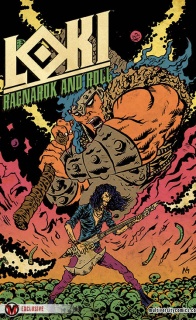
Written by Eric Esquivel
Art by Jerry GaylordWHY WE LOVE IT: Up-and-coming writer Eric Esquivel first caught our attention with Thor: The Unkillable Thunder Christ, and wowed us with his work on FREELANCERS. When he told us he wanted to bring those sensibilities to the trickster god Loki, we had to say “Yes!” Pairing him with FANBOYS VS ZOMBIES artist Jerry Gaylord sealed the deal.
WHY YOU’LL LOVE IT: Loki steps out of the shadow cast by his thunderous brother as Norse mythology crosses over with the only thing on Earth as wild and crazy…rock and roll!
WHAT IT’S ABOUT: What happens when Odin banishes Loki to Earth? He finds a world of outcasts that appreciate his style! While his kin sharpen their weapons, he picks up an electric guitar.
I don’t know what forces conspired to make me Multiversity’s expert on all things Loki, but here we are with “Loki: Ragnarok and Roll.” Don’t let my seeming indifference fool you though, “Ragnarok and Roll” proves itself to be vastly different from Marvel’s pretty boy with a heart of tarnished gold.
Chalk that up to Gaylord who offers up a version of Asgard vastly different from the one we’ve been exposed to for years. A grand city entrenched in the world tree, this Asgardia feels more druidic, more natural, than the Kirby space so commonplace now. Thor’s not the blonde hunk we know, and Loki’s a downtrodden god of mischief. If anything, “Ragnrok and Roll” feels more in line with the original Norse mythology, which is what I feel is the most important aspect about “Ragnarok and Roll.” Despite the fact that we are now in Golden Age of Loki Fangirl/Fanboying, “R&R” is hardly a shameless cash-in. Instead, it’s an original look at the God of Mischief that, though we may have seen in bursts, comes with a unique twist here.
Namely the Rock and Roll part. I mean, it’s all over the cover and solicitation so I think I’m allowed to say that here, Loki finds acceptance through the LA underground rock scene. It’s an interesting twist on the mythos, a little reminiscent of “Punk Rock Jesus” but with plenty of thematic differences that make any similarities superfluous. Here, Loki’s an outcast, as he’s been in almost every appearance since the 20th century, but for reasons that drive him far away from villain territory, past anti-hero and just short of hero. It’s an interesting concept on Thor and Loki’s relationship on Esquivel’s part and one that delivers some hilarious moments, especially from Thor who’s the drunken musclebound braggart from the original mythology here.
Much of said comedy is delivered expertly by Gaylord whose art here is an excellent mix of comedy, incredibly mild drama, and nun strippers. “Ragnarok and Roll” has wide variety in its settings and Gaylord doesn’t miss a beat. From the halls of Asgard to goth nightclubs of LA, Gaylord’s art is consistent, giving the clubgoers the same energy he gives to his gods. Speaking of which, there’s an almost Sandman like assemblage of gods here but “Ragnarok and Roll” beats out “Season of Mists” by straight up involving (MILD SPOILERS) The Flying Spaghetti Monster. I’m not sure if this is the first time the word “meme” has been used in a comic, but it’s about damn time the Pastafarians have been given their proper representation.
On the more mundane side of things (and I use the term “mundane” incredibly loosely), the nightclub Loki stumbles into has the same type of energy found in Asgard, where mortals find their power through cage dancing and tattoos rather than runes and gods, as definitively shown in one splash page that captures the feeling of a stage dive.
Really, “Ragnarok and Roll” captures a lot of things right about the scene Loki finds himself in. With unassuming dialogue from Esquivel that’d draw readers into this lifestyle the same way Loki is. There’s also a great scene where Loki puts down what many would call a hater, leading into my favorite resolution to any confrontation ever. If anyone reads this book and would let to solve a fight with me the way Loki does, feel free to.
Continued belowIf there’s a fault to be had in “Loki: Ragnarok and Roll” it’s the seeming lack of any stakes. Even though Loki’s been banished to Midgard, there seems to be no reason for him to go back. There’s hints of a great plot at work but they’re hidden under an examination of what it means to be the rebellious son and LA culture. Honestly though, there’s something to be said for books that take the time to relax the way “Ragnarok and Roll” does.
Final Verdict: 7.8 – A definite browse with a lean towards buy. It’s absolutely worth checking out at the very least.



